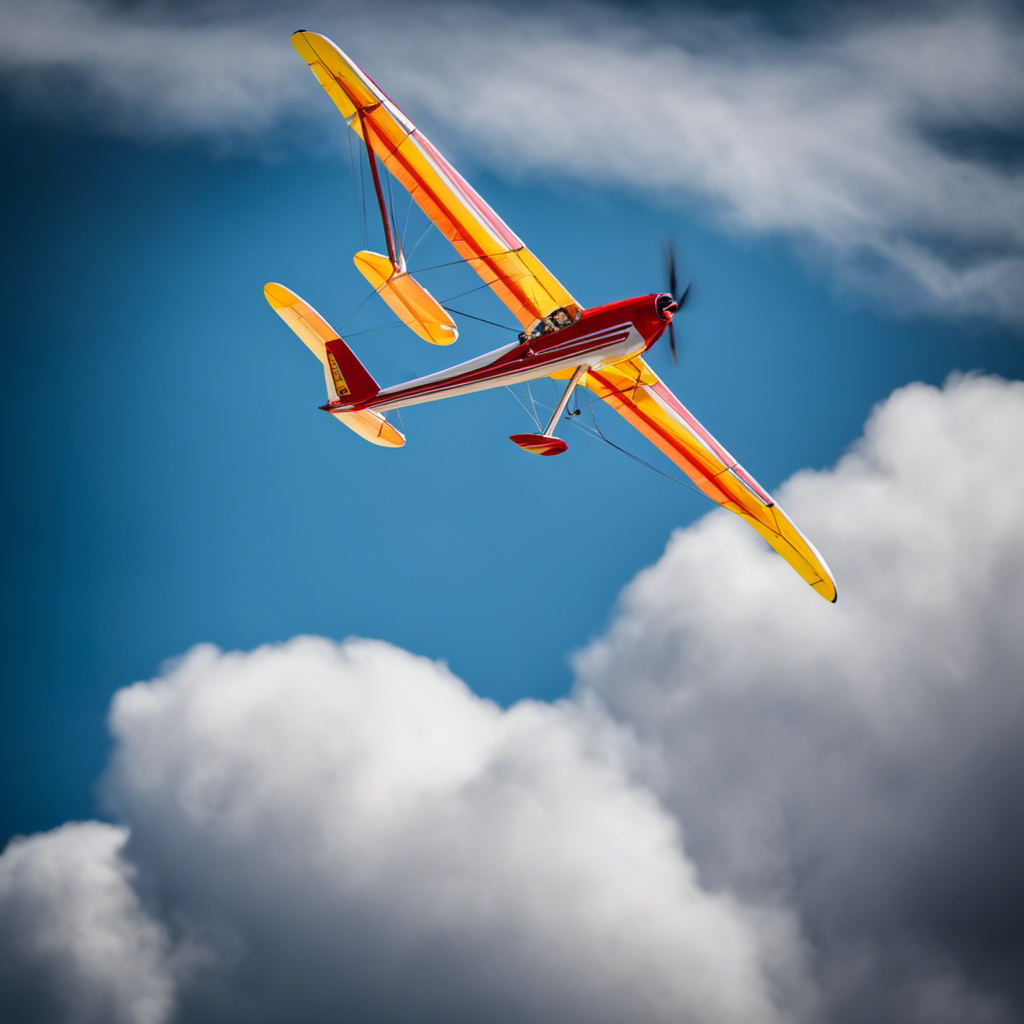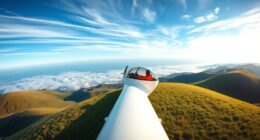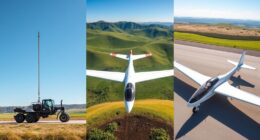As a glider pilot, I’ve always been captivated by the exhilarating world of aerobatics. The rush of soaring through the sky, defying gravity with precision and skill, is truly incomparable.
In this comprehensive guide, I will delve into the basics of aerobatics in gliding, breaking down the maneuvers, discussing safety measures, and exploring the necessary equipment and modifications.
Join me on this journey as we uncover the secrets of advanced techniques, certification requirements, and even the thrilling world of competitions. Get ready to perfect your skills and experience the sheer joy of aerobatics in gliding.
Key Takeaways
- Aerobatics in gliding combines precision, skill, and finesse.
- Understanding aerobatic maneuvers such as rolls, spins, loops, and stall turns is crucial.
- Safety measures and precautions, including training and certification, are necessary for safe aerobatic maneuvers.
- Properly maintained equipment and gear, such as harnesses, parachutes, helmets, and goggles, are essential for a safe flight experience.
The Basics of Aerobatics in Gliding
Now let’s dive into the basics of aerobatics in gliding and learn how to perform thrilling stunts in the air. Aerobatics in gliding is a captivating sport that combines precision, skill, and finesse. It involves performing a series of advanced maneuvers in an aircraft without an engine, relying solely on the forces of nature to stay aloft.
These maneuvers are not only visually stunning but also require a deep understanding of aerodynamics and the glider’s capabilities.
Aerobatic competitions are held worldwide, where pilots showcase their skills by executing complex sequences of figures. These competitions are judged based on criteria such as precision, control, and artistic impression. To participate in these events, pilots must master a variety of advanced maneuvers.
Some of the most common advanced maneuvers in glider aerobatics include loops, rolls, spins, and stall turns. Each maneuver requires precise control inputs and a thorough understanding of the aerodynamic forces at play. Loops involve a continuous climb followed by a descent, while rolls require the aircraft to rotate around its longitudinal axis. Spins, on the other hand, involve a controlled autorotation, where the glider spirals downwards. Lastly, stall turns involve a combination of a stall and a turn, resulting in a 180-degree change in direction.
Mastering these advanced maneuvers is a gradual process that requires practice, patience, and dedication. As pilots become more proficient, they can begin incorporating these maneuvers into intricate sequences that truly highlight their skills and creativity.
Understanding the Aerobatic Maneuvers
To understand the aerobatic maneuvers, you’ll need to familiarize yourself with the different types of rolls, spins, and loops. These maneuvers are the bread and butter of aerobatics in gliding. Rolls refer to the rotation of the aircraft around its longitudinal axis. There are several types of rolls, including the aileron roll, barrel roll, and snap roll. Each roll requires precise control inputs and coordination to execute properly.
Spins, on the other hand, involve a controlled stall of the aircraft, resulting in a sustained autorotation. Spins can be both upright and inverted, and they require a thorough understanding of aerodynamics and recovery techniques.
Loops, as the name suggests, involve flying the glider in a vertical oval-shaped trajectory. They require a combination of speed, altitude, and control inputs to perform correctly.
Understanding these aerobatic maneuvers is crucial for anyone pursuing aerobatic training. It is important to note that aerobatics can be physically demanding and mentally challenging. Therefore, proper training and practice are essential to ensure safety and proficiency.
Now that we have covered the basics of aerobatic maneuvers, let’s move on to the next section, where we will discuss the safety measures and precautions that should be taken when engaging in aerobatics in gliding.
Safety Measures and Precautions
When it comes to ensuring safety in aerobatics, there are three key areas that require attention: equipment and gear, training and certification, and emergency procedures and protocols.
First and foremost, having the right equipment and gear is essential for a safe aerobatic experience. This includes ensuring that the aircraft is properly maintained and equipped with the necessary safety features.
Secondly, proper training and certification are crucial for pilots to have the skills and knowledge needed to perform aerobatic maneuvers safely. This involves rigorous training programs and obtaining the appropriate certifications from aviation authorities.
Lastly, having well-defined emergency procedures and protocols in place is essential to handle any unforeseen circumstances or emergencies that may arise during aerobatic maneuvers. This includes protocols for communication, emergency landings, and emergency exits.
Equipment and Gear
Gliders require specific equipment and gear to safely perform aerobatics. The right gliding gear and proper equipment maintenance are crucial for ensuring a smooth and safe flight experience. Let’s take a closer look at the essential gear and equipment needed for aerobatics in gliding.
| Gear | Purpose |
|---|---|
| Harness | Provides secure attachment to the glider and allows for control during maneuvers. |
| Parachute | Serves as a last resort in case of emergency, providing a means of escape from the glider. |
| Helmet | Protects the head from potential impacts during aerobatic maneuvers. |
| Goggles | Shield the eyes from wind, debris, and glare, ensuring clear vision. |
To maintain the gliding equipment, regular maintenance is necessary. This includes inspecting and servicing the glider, checking the integrity of the harness and parachute, and ensuring the helmet and goggles are in good condition. Regular maintenance not only enhances safety but also extends the lifespan of the equipment. Prioritizing the upkeep of gliding gear is vital for a successful and enjoyable aerobatic gliding experience.
Training and Certification
Training and certification are essential for pilots to safely perform aerobatics in gliders. To acquire the necessary skills and knowledge, aspiring aerobatic glider pilots should consider enrolling in reputable aerobatic flight schools.
These specialized institutions offer comprehensive training programs designed to teach pilots the intricacies of aerobatic maneuvers and techniques specific to gliding. Expert aerobatic flight instructors play a crucial role in guiding and mentoring pilots throughout their training journey. These instructors possess extensive experience and expertise in aerobatics and are equipped to provide personalized instruction and feedback to help pilots refine their skills.
Emergency Procedures and Protocols
In case of an emergency, you should be familiar with the proper procedures and protocols to ensure your safety while flying a glider. One of the most critical emergency procedures is the emergency landing. When facing an emergency landing, it is crucial to remain calm and assess the situation.
Look for a suitable landing spot and communicate your intentions with other gliders in the area. During the landing, maintain control of the glider and be prepared for a potential impact. Once on the ground, follow the first aid procedures if necessary. This may include administering CPR, controlling bleeding, or providing basic life support.
It is essential to have a thorough understanding of first aid techniques to effectively respond to any medical emergencies that may arise during a gliding flight.
Equipment and Modifications for Aerobatics
When it comes to modifications for aerobatics, safety considerations should be the top priority. Any changes made to the aircraft should be thoroughly evaluated and approved by certified professionals to ensure that they do not compromise the structural integrity or flight characteristics of the glider.
Additionally, it is crucial to use recommended aerobatics equipment that is specifically designed and tested for high-stress maneuvers. This includes reinforced wings, harness systems, and emergency parachutes. These measures help to mitigate potential risks and enhance overall safety during aerobatic flights.
Safety Considerations for Modifications
Before making any modifications to your glider, it’s important to consider the safety implications. Safety regulations and risk assessment play a crucial role in ensuring the well-being of both the pilot and the aircraft.
When it comes to modifications, here are two important factors to keep in mind:
-
Structural Integrity:
-
Evaluate the impact of the modification on the overall structure of the glider.
-
Assess if the modification compromises the strength and stability of the aircraft.
-
Systems Integration:
-
Consider how the modification affects the existing systems of the glider.
-
Determine if any additional safety measures are required to maintain proper functioning.
Recommended Aerobatics Equipment
To enhance your glider’s aerobatic capabilities, it’s recommended that you invest in the proper equipment. This includes aerobatic clothing and aerobatic accessories.
When it comes to aerobatic clothing, it is important to prioritize safety and comfort. Look for clothing that is fire-resistant and provides adequate protection in case of an accident. Additionally, choose clothing that allows for a full range of motion and is breathable to keep you comfortable during intense maneuvers.
As for aerobatic accessories, consider investing in a high-quality aerobatic helmet, gloves, and goggles. These accessories will not only protect you but also enhance your overall aerobatic experience.
With the right equipment, you can confidently take on the skies and push the limits of your glider’s capabilities.
Now that you have the proper equipment, it’s time to discuss the training and certification requirements for aerobatics in gliding.
Training and Certification Requirements
You should ensure that you meet the necessary training and certification requirements to engage in aerobatics in gliding. Before you can perform exhilarating aerobatic maneuvers in a glider, it is essential to undergo proper training and obtain the required certifications.
Here are a few key training techniques and certification requirements to consider:
-
Training Techniques:
-
Basic Aerobatic Maneuvers: You will learn fundamental aerobatic maneuvers such as loops, rolls, spins, and stall turns. These maneuvers require precise control inputs and coordination.
-
Safety Procedures: Emphasis is placed on safety procedures and emergency situations. You will learn how to recover from unusual attitudes and spins, ensuring your safety during aerobatic flights.
-
Certification Requirements:
-
Glider Pilot License: To engage in aerobatics, you must possess a valid glider pilot license. This license demonstrates your knowledge and skills in glider flying.
-
Aerobatic Endorsement: Additionally, you will need an aerobatic endorsement on your license, which certifies your ability to perform aerobatic maneuvers safely.
By meeting these training and certification requirements, you can confidently embark on your journey into the world of aerobatics in gliding.
Now, let’s explore the realm of advanced aerobatic techniques.
Advanced Aerobatic Techniques
After completing the necessary training and certification requirements, I was eager to delve into the world of advanced aerobatic techniques in gliding. These maneuvers require precision, skill, and a deep understanding of the aerodynamics involved.
One of the most thrilling advanced aerobatic maneuvers is the vertical roll. This involves rolling the glider while keeping it in a vertical climb. It requires impeccable timing and control to maintain the proper angle of attack and avoid stalling.
Another exhilarating maneuver is the inverted flight. In this maneuver, the glider is flown upside down, with the wings generating lift in the opposite direction. It takes significant practice and concentration to maintain control and ensure a smooth transition into and out of inverted flight.
To develop these advanced aerobatic skills, specialized training techniques are employed. These include simulated flight exercises on ground-based simulators, allowing pilots to practice the complex sequences of maneuvers without the risks associated with actual flight. Additionally, advanced aerobatic training techniques often involve flying with experienced instructors who can provide guidance and feedback in real-time.
Mastering advanced aerobatic maneuvers and techniques is a testament to the pilot’s dedication and skill. It requires countless hours of practice, a deep understanding of aerodynamics, and a commitment to safety. However, the thrill and satisfaction of executing these maneuvers with precision and grace make it all worthwhile.
Competitions and Events in Aerobatics
Competitions and events in aerobatics provide pilots with opportunities to showcase their skills and compete against fellow aviators in a thrilling and adrenaline-filled environment. These high-stakes competitions push pilots to their limits, demanding precision, technique, and flawless execution.
Participating in these events not only allows pilots to test their abilities but also fosters a sense of camaraderie and community among aviators.
In the intense world of aerobatic competitions, every maneuver is meticulously planned and executed with utmost precision. Pilots must master a wide range of techniques, including loops, rolls, spins, and hammerheads, to impress the judges and secure victory. The adrenaline rush experienced during these competitions is unmatched, as pilots push their aircraft to the limits of its performance envelope, defying gravity and pushing the boundaries of what is possible in flight.
For pilots, the thrill of competing against the best in the field is unparalleled. The sense of accomplishment and fulfillment that comes from executing a flawless routine and receiving recognition for one’s skills is indescribable. These competitions also serve as a platform to learn from and be inspired by other aviators, fostering a continuous improvement mindset.
The atmosphere at these events is electric, with spectators witnessing breathtaking displays of skill, courage, and precision. The combination of technical mastery and artistic flair in aerobatic performances creates an emotional connection with the audience, leaving them awe-inspired and captivated by the sheer beauty and elegance of flight.
Tips for Perfecting Your Aerobatic Skills
Now that we have explored the exciting world of aerobatic competitions and events, let’s turn our attention to some valuable tips for perfecting your aerobatic skills.
To excel in aerobatics, it is essential to master a range of advanced maneuvers. These maneuvers require precise control of the glider and a deep understanding of aerodynamics. One such maneuver is the loop, where the glider performs a complete vertical circle. To execute this maneuver flawlessly, it is crucial to maintain a constant speed and pull back on the control stick smoothly to initiate the climb.
Another essential maneuver is the roll, where the glider rotates around its longitudinal axis. Achieving a smooth and coordinated roll requires precise rudder and aileron inputs. It is crucial to maintain a constant speed and use gentle control inputs to avoid over-controlling the glider.
Lastly, the stall turn is a challenging maneuver that involves a vertical climb, followed by a 180-degree turn at the top. Proper timing and control inputs are crucial to executing this maneuver correctly.
Frequently Asked Questions
What Are the Potential Risks and Dangers Associated With Aerobatics in Gliding?
Potential risks and dangers of aerobatics in gliding include structural failure, disorientation, and loss of control. Safety precautions and training are crucial to mitigate these risks.
Pilots must undergo rigorous training to develop the necessary skills and knowledge to perform aerobatics safely. They must also ensure that the glider is in optimal condition and adhere to weight and balance limitations.
Regular inspections and maintenance are essential to minimize the risk of structural failure during high-stress maneuvers.
Is There a Minimum Age Requirement for Participating in Aerobatics in Gliding?
There is a minimum age requirement for participating in aerobatics in gliding. By imposing a minimum age requirement, it helps to ensure the safety and well-being of individuals engaging in aerobatics in gliding. Safety precautions are of utmost importance when it comes to this activity. It is essential to ensure that participants are of a certain age to have the physical and mental capability to handle the challenges and potential risks involved.
Are There Any Restrictions on the Types of Gliders That Can Be Used for Aerobatics?
There are certain restrictions on the types of gliders that can be used for aerobatics. Safety measures play a crucial role in ensuring a smooth and enjoyable experience.
When it comes to selecting the right glider, factors such as structural strength, maneuverability, and weight are taken into consideration. The glider must be capable of withstanding the forces exerted during aerobatic maneuvers.
Adhering to these guidelines ensures both the pilot’s safety and the overall success of the aerobatic performance.
Are There Any Specific Medical Conditions That Could Disqualify Someone From Participating in Aerobatics in Gliding?
Specific medical conditions can disqualify individuals from participating in aerobatics in gliding due to safety concerns. It is important to prioritize the well-being of pilots and passengers.
Certain conditions, such as heart conditions, epilepsy, or uncontrolled high blood pressure, may pose risks during aerobatic maneuvers. These conditions can lead to loss of consciousness or other impairments, jeopardizing the safety of everyone involved.
Prior to engaging in aerobatics in gliding, it is crucial to undergo a thorough medical assessment to ensure the absence of any disqualifying conditions.
What Are Some Common Misconceptions or Myths About Aerobatics in Gliding That You Would Like to Debunk?
Misconceptions and safety concerns surrounding aerobatics in gliding are prevalent.
One common misconception is that gliders are not designed for such maneuvers. However, gliders used in aerobatics are specifically built to withstand the stresses involved.
Another myth is that aerobatics in gliding is extremely dangerous. While it carries inherent risks, with proper training, adherence to safety protocols, and regular maintenance, the level of risk can be effectively managed.
Safety is of paramount importance in this exhilarating sport.
Conclusion
In conclusion, aerobatics in gliding is an exhilarating and challenging discipline that requires skill, precision, and dedication. It is a sport that pushes the boundaries of what is possible in a glider and allows pilots to showcase their expertise.
One interesting statistic that can evoke emotion is that only a small percentage of glider pilots are certified to perform aerobatics, highlighting the rarity and exclusivity of this skill. So, if you are one of those few who have mastered aerobatics, you can take pride in being part of an elite group.




